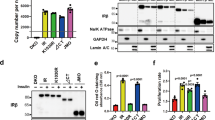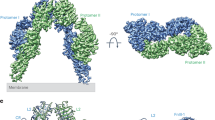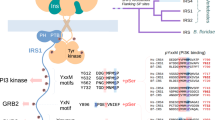Abstract
Tyrosine 1062 of Ret, which represents an intracytoplasmic docking site for multiple signaling molecules, is essential for Ret-mediated activation of phosphatidylinositol 3-Kinase (PI3-K). PI3-K, in turn, has been implicated in inducing cell survival and neoplastic transformation mediated by Ret. We have examined the mechanisms by which Ret stimulates PI3-K. Here we show that the Insulin Receptor Substrate-1 (IRS-1) is tyrosine phosphorylated and associated with the p85 regulatory subunit of PI3-K in response to Ret activation. IRS-1 coimmunoprecipitates with Ret and co-expression of IRS-1 results in the potentiation of Ret-mediated activation of Akt(PKB), a bona fide effector of PI3-K. The association with the PTB domain of IRS-1 depends on the phosphorylation of tyrosine 1062 of Ret. The deletion of asparagine 1059 (delN1059) and the substitution of leucine 1061 (L1061P), two Ret mutations identified in families affected by congenital megacolon (Hirschsprung's disease), impair the binding of IRS-1 to Ret as well as Ret-mediated Akt(PKB) stimulation. Finally, we show that Shc, which was previously identified as another ligand of Y1062 of Ret, competes with IRS-1 for the binding to Ret pY1062. All together, these findings suggest that IRS-1 is a component of the signaling pathway which leads to Ret-mediated PI3-K activation, a pathway which can be targeted by Hirschsprung-associated Ret mutations. The alternative binding of Shc and IRS-1 to Ret pY1062 can be a system to modulate the activation of different intracellular signaling pathways and to elicit different biological responses following Ret activation.
This is a preview of subscription content, access via your institution
Access options
Subscribe to this journal
Receive 50 print issues and online access
$259.00 per year
only $5.18 per issue
Buy this article
- Purchase on Springer Link
- Instant access to full article PDF
Prices may be subject to local taxes which are calculated during checkout





Similar content being viewed by others
References
Airaksinen MS, Titievsky A and Saarma M. . 1999 Mol. Cell. Neurosci. 13: 313–325.
Alberti L, Borrello MG, Ghizzoni S, Torriti F, Rizzetti MG and Pierotti MA. . 1998 Oncogene 17: 1079–1087.
Arighi E, Alberti L, Torriti F, Ghizzoni S, Rizzetti MG, Pelicci G, Pasini B, Bongarzone I, Piutti C, Pierotti MA and Borrello MG. . 1997 Oncogene 14: 773–782.
Asai N, Murakami H, Iwashita T and Takahashi M. . 1996 J. Biol. Chem. 271: 17644–17649.
Bellacosa A, Chan TO, Ahmed NN, Datta K, Malstrom S, Stokoe D, McCormick F, Feng J and Tsichlis P. . 1998 Oncogene 17: 313–325.
Besset V, Scott RP and Ibanez CF. . 2000 J. Biol. Chem. (in press).
Bonni A, Brunet A, West AE, Datta SR, Takasu MA and Greenberg ME. . 1999 Science 286: 1358–1362.
Borrello MG, Alberti L, Arighi E, Bongarzone I, Battistini C, Bardelli A, Pasini B, Piutti C, Rizzetti MG, Mondellini P, Radice MT and Pierotti MA. . 1996 Mol. Cell. Biol. 16: 2151–2163.
Carlomagno F, Melillo RM, Visconti R, Salvatore G, De Vita G, Lupoli G, Yu Y, Jing S, Vecchio G, Fusco A and Santoro M. . 1998 Endocrinology 139: 3613–3619.
Datta SR, Brunet A and Greenberg ME. . 1999 Genes Dev. 13: 2905–2927.
De Vita G, Melillo RM, Carlomagno F, Visconti R, Castellone MD, Bellacosa A, Billaud M, Fusco A, Tsichlis PN and Santoro M. . 2000a Cancer Res. 60: 3727–3731.
De Vita G, Berlingieri MT, Visconti R, Castellone MD, Viglietto G, Baldassarre G, Zannini MS, Bellacosa A, Tsichlis PN, Fusco A and Santoro M. . 2000b Cancer Res. 60: 3916–3920.
Durick K, Gill GN and Taylor SS. . 1998 Mol. Cell. Biol. 18: 2298–2308.
Geneste O, Bidaud C, Vita GD, Hofstra RM, Tartare-Deckert S, Buys CH, Lenoir GM, Santoro M and Billaud M. . 1999 Hum. Mol. Genet. 8: 1989–1999.
Johnston JA, Wang LM, Hanson EP, Sun XJ, White MF, Oakes SA, Pierce JH and O'Shea JJ. . 1995 J. Biol. Chem. 270: 28527–28530.
Hayashi H, Ichihara M, Iwashita T, Murakami H, Shimono Y, Kawai K, Kurokawa K, Murakumo Y, Imai T, Funahashi H, Nakao A and Takahashi M. . 2000 Oncogene 19: 4469–4475.
Keegan AD, Nelms K, White M, Wang LM, Pierce JH and Paul WE. . 1994 Cell 76: 811–820.
Liang L, Zhou T, Jiang J, Pierce JH, Gustafson TA and Frank SJ. . 1999 Endocrinology 140: 1972–1983.
Liu X, Vega QC, Decker RA, Pandey A, Worby CA and Dixon JE. . 1996 J. Biol. Chem. 271: 5309–5312.
Lorenzo MJ, Gish GD, Houghton C, Stonehouse TJ, Pawson T, Ponder BA and Smith DP. . 1997 Oncogene 14: 763–771.
Marshall CJ. . 1995 Cell 80: 179–185.
Matoskova B, Wong WT, Salcini AE, Pelicci PG and Di Fiore PP. . 1995 Mol. Cell. Biol. 15: 3805–3812.
Meakin SO, MacDonald JI, Gryz EA, Kubu CJ and Verdi JM. . 1999 J. Biol. Chem. 274: 9861–9870.
Melillo RM, Barone MV, Lupoli G, Cirafici AM, Carlomagno F, Visconti R, Matoskova B, Di Fiore PP, Vecchio G, Fusco A and Santoro M. . 1999 Cancer Res. 59: 1120–1126.
Murakami H, Iwashita T, Asai N, Iwata Y, Narumiya S and Takahashi M. . 1999a Oncogene 18: 1975–1982.
Murakami H, Iwashita T, Asai N, Shimono Y, Iwata Y, Kawai K and Takahashi M. . 1999b Biochem. Biophys. Res. Commun. 262: 68–75.
Myers Jr MG, Grammer TC, Wang LM, Sun XJ, Pierce JH, Blenis J and White MF. . 1994 J. Biol. Chem. 269: 28783–28789.
Myers Jr MG, Zhang Y, Aldaz GA, Grammer T, Glasheen EM, Yenush L, Wang LM, Sun XJ, Blenis J, Pierce JH and White MF. . 1996 Mol. Cell. Biol. 16: 4147–4155.
Pandey A, Duan H, Di Fiore PP and Dixit VM. . 1995 J. Biol. Chem. 270: 21461–21463.
Pandey A, Liu X, Dixon JE, Di Fiore PP and Dixit V. . 1996 J. Biol. Chem. 271: 10607–10610.
Pasini B, Ceccherini I and Romeo G. . 1996 Trends Genet. 12: 138–144.
Pawson T and Scott JD. . 1997 Science 278: 2075–2080.
Pelicci G, Lanfrancone L, Grignani F, McGlade J, Cavallo F, Forni G, Nicoletti I, Grignani F, Pawson T and Pelicci PG. . 1992 Cell 70: 93–104.
Pierotti MA, Bongarzone I, Borello MG, Greco A, Pilotti S and Sozzi G. . 1996 Genes Chrom. Cancer 16: 1–14.
Ponder BA. . 1999 Cancer Res. 59: 1736–1741.
Rameh LE and Cantley LC. . 1999 J. Biol. Chem. 274: 8347–8350.
Rosenthal A. . 1999 Neuron 22: 201–203.
Santoro M, Carlomagno F, Romano A, Bottaro DP, Dathan NA, Grieco M, Fusco A, Vecchio G, Matoskova B, Kraus MH and Di Fiore PP. . 1995 Science 267: 381–383.
Santoro M, Wong WT, Aroca P, Santos E, Matoskova B, Grieco M, Fusco A and Di Fiore PP. . 1994 Mol. Cell. Biol. 14: 663–675.
Schlessinger J. . 1993 Trends Biochem. Sci. 18: 273–275.
Schlessinger J. . 1994 Curr. Opin. Genet. Dev. 4: 25–30.
Segouffin-Cariou C and Billaud M. . 2000 J. Biol. Chem. 275: 3568–3576.
Siegal G. . 1999 Nat. Struct. Biol. 6: 7–10.
Skolnik EY, Batzer A, Li N, Lee CH, Lowenstein E, Mohammadi M, Margolis B and Schlessinger J. . 1993 Science 260: 1953–1955.
Trupp M, Scott R, Whittemore SR and Ibanez CF. . 1999 J. Biol. Chem. 274: 20885–20894.
Uddin S, Yenush L, Sun XJ, Sweet ME, White MF and Platanias LC. . 1995 J. Biol. Chem. 270: 15938–15941.
van der Geer P, Wiley S and Pawson T. . 1999 Oncogene 18: 3071–3075.
van Weering DH, de Rooij J, Marte B, Downward J, Bos JL and Burgering BM. . 1998 Mol. Cell. Biol. 18: 1802–1811.
Voliovitch H, Schindler DG, Hadari YR, Taylor SI, Accili D and Zick Y. . 1995 J. Biol. Chem. 270: 18083–18087.
Wang LM, Myers Jr MG, Sun XJ, Aaronson SA, White M and Pierce JH. . 1993 Science 261: 1591–1594.
White MF. . 1998 Recent Prog. Horm. Res. 53: 119–138.
Wolf G, Trub T, Ottinger E, Groninga L, Lynch A, White MF, Miyazaki M, Lee J and Shoelson SE. . 1995 J. Biol. Chem. 270: 27407–27410.
Yamada M, Ohnishi H, Sano S, Nakatani A, Ikeuchi T and Hatanaka H. . 1997 J. Biol. Chem. 272: 30334–30339.
Yin T, Keller SR, Quelle FW, Witthuhn BA, Tsang ML, Lienhard GE, Ihle JN and Yang YC. . 1995 J. Biol. Chem. 270: 20497–20502.
Zhou MM, Huang B, Olejniczak ET, Meadows RP, Shuker SB, Miyazaki M, Trub T, Shoelson SE and Fesik SW. . 1996 Nat. Struct. Biol. 3: 388–393.
Acknowledgements
We thank A Bellacosa and P Tsichlis for the Ha-Akt and D Accili for the IRS-1 plasmid. We are grateful to F Sferratore and AM Cirafici for technical assistance. This study was supported by the Associazione Italiana per la Ricerca sul Cancro (AIRC), the EC grants BMH4-CT96-0814 and BMH4-CT97-2157, grants from the MURST, the progetto Biotecnologie 5% of the Consiglio Nazionale delle Ricerche (CNR), and the Ligue Nationale Contre le Cancer. F Carlomagno was supported by a fellowship of the Telethon Foundation. This paper was written while G Vecchio was a Scholar-in-Residence at the Fogarty International Center for Advanced Study in the Health Sciences, National Institutes of Health, Bethesda, MD, USA.
Author information
Authors and Affiliations
Rights and permissions
About this article
Cite this article
Melillo, R., Carlomagno, F., De Vita, G. et al. The insulin receptor substrate (IRS)-1 recruits phosphatidylinositol 3-kinase to Ret: evidence for a competition between Shc and IRS-1 for the binding to Ret. Oncogene 20, 209–218 (2001). https://doi.org/10.1038/sj.onc.1204049
Received:
Revised:
Accepted:
Published:
Issue Date:
DOI: https://doi.org/10.1038/sj.onc.1204049
Keywords
This article is cited by
-
PI3K/Akt/mTOR signaling in medullary thyroid cancer: a promising molecular target for cancer therapy
Endocrine (2015)
-
XB130, a tissue-specific adaptor protein that couples the RET/PTC oncogenic kinase to PI 3-kinase pathway
Oncogene (2009)
-
Differential requirement of Tyr1062 multidocking site by RET isoforms to promote neural cell scattering and epithelial cell branching
Oncogene (2004)
-
Protein kinase Cα activation by RET: evidence for a negative feedback mechanism controlling RET tyrosine kinase
Oncogene (2003)
-
RET/PTC1 oncogene signaling in PC Cl 3 thyroid cells requires the small GTP-binding protein Rho
Oncogene (2001)



